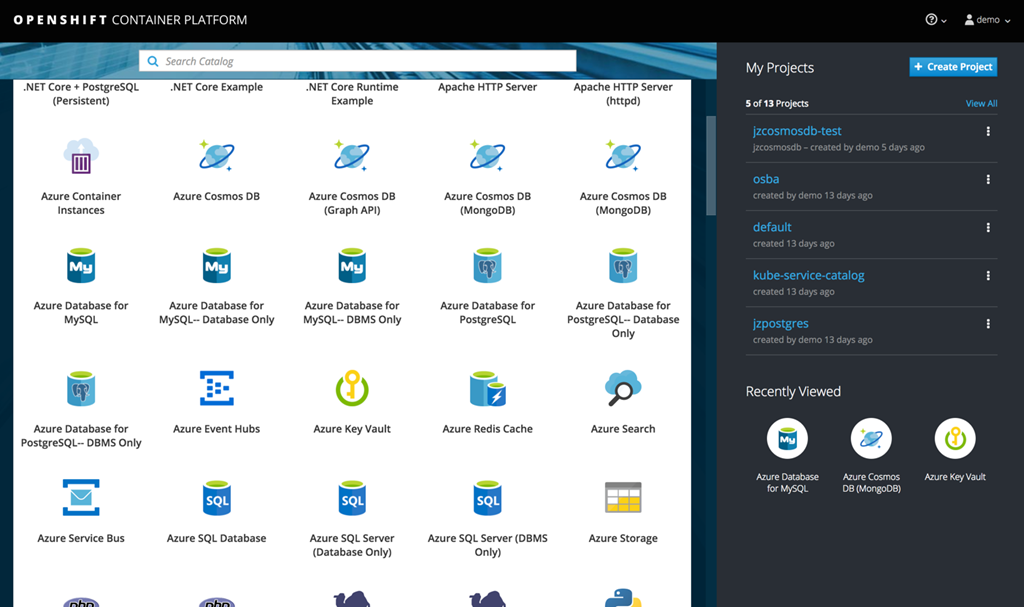Hi, Habr! At the Red Hat Summit 2018 in San Francisco, we, together with Red Hat, presented OpenShift on the Azure platform - the first fully managed and easy-to-use container platform OpenShift as a cloud service. Today we will talk about it in more detail and tell you how you can get more insiders. Look under the cat!

After OpenShift Dedicated on Azure was announced last year, Microsoft and Red Hat created a new solution based on user feedback. It offers customers much more than the original version of the product. OpenShift Dedicated is a fully managed and customizable solution, making it easy and convenient to use on Azure.
What does “fully controlled” mean? Red Hat and Microsoft will jointly develop, manage, and support OpenShift on Azure. Being a fully managed service, it will receive ongoing support as a single project, thereby providing comprehensive user support that is not inferior in quality to Azure support. According to our customers, when using other cloudy OpenShift solutions, they did not have the advantages resulting from the use of services within a single provider. We are pleased to be able to meet this important need.
Although OpenShift is used in many cloud environments today, the recently announced Azure OpenShift has become easier to configure and use with native Azure integration mechanisms, you can also use Kubernetes, the underlying Azure Kubernetes Service.
If you want to create a new OpenShift cluster, you do not need to create a service request and spend several hours waiting for the network components to connect (as it does in other clouds). Instead, you can use the Azure CLI to execute various commands:

Get a new cluster in minutes, faster and easier than other public cloud solutions available now.
Open Service Broker for Azure (OSBA) also works with OpenShift for Azure, including the Azure Stack, and automatically detects and displays a list of available Azure services such as Cosmos DB, Azure KeyVault, and others. OSBA increases the effectiveness of everything you implement using OpenShift on Azure, allowing you to easily integrate other objects moved to Azure. This is another handy feature that allows you to quickly launch a project, as well as connect it to other existing or planned projects on Azure.

What's even nicer for customers is that all of this is attached to the recently announced Azure Stack and Windows Container support for the local OpenShift Container platform, which is perfect for corporate customers who want to use a hybrid cloud container platform that is simultaneously supported on both RHEL and Windows Learn how to deploy the OpenShift Container Platform to the Azure Stack right now.
Availability
The Red Hat OpenShift solution on Azure is expected to be available in the coming months as an open demo. The Red Hat OpenShift Container and Red Hat Enterprise Linux platforms are currently available on Azure and Azure Stack.
If you want more insights
On June 16 in Moscow at the
DevOps Days Microsoft conference together with Red Hat will hold a master class "DevOps, Red Hat, Microsoft and all-all-all." At the master class, we will show you how quickly and beautifully your daily tasks are solved in the Red Hat OpenShift Container Platform on Microsoft Azure.
What will happen?
- The source2image mechanism in OpenShift. You (and your colleagues in the DevOps team) just take a link to git and give it to Openshift, then it will do everything by itself: it will assemble itself and deploy the application, show the metric, log, otmashabiruet on the given nodes to the specified values. Developers do not need to bother with what and how to do at the infrastructure level, they just continue to do the usual work, with the usual means - they write code, clone their repositories - and wait until they get together.
- Accounting and control. Expanding WordPress from a container image to make a lookup for your cat. We show how our container does not start just like that, because it needs privileges. We will tell and show how things are going with security on this example and give special privileges to the container, then we will see how it will start up, link the database to it and make the first super blog post.
- Schrödinger or Blue / Green Deployment colored squares through the Jenkins Pipeline, which we deploy in one (but not exactly) click in OpenShift - a spherical scenario in vacuum, showing how to make the new version of the application available to the user with zero downtime and without loss of nerves both dev and ops.
Speakers
 Ivan Fateev
Ivan Fateev is a technological evangelist in Microsoft Russia. Ivan specializes in modern application architecture and best practices in software development. Ivan has extensive experience both in server development and in client. He began his web development career in 2008. Then in 2010, he switched to client development of iOS applications, then games. At the moment, Ivan specializes in developing applications using cloud technologies.
 Pavel Mamontov
Pavel Mamontov - Production company "Aquarius". Open Source Advocate. Leading Container Technology Specialist at Aquarius Production Company, NKK.